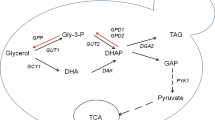Abstract
Strains of Yarrowia lipolytica were engineered to express the poly-3-hydroxybutyrate (PHB) biosynthetic pathway. The genes for β-ketothiolase, NADPH-dependent acetoacetyl-CoA reductase, and PHB synthase were cloned and inserted into the chromosome of Y. lipolytica. In shake flasks, the engineered strain accumulated PHB to 1.50 and 3.84% of cell dry weight in complex medium supplemented with glucose and acetate as carbon source, respectively. In fed-batch fermentation using acetate as sole carbon source, 7.35 g/l PHB (10.2% of cell dry weight) was produced. Selection of Y. lipolytica as host for PHB synthesis was motivated by the fact that this organism is a good lipids producer, which suggests robust acetyl-CoA supply also the precursor of the PHB pathway. Acetic acid could be supplied by gas fermentation, anaerobic digestion, and other low-cost supply route.




Similar content being viewed by others
References
Carlson R, Srienc F (2006) Effects of recombinant precursor pathway variations on poly [(R)-3-hydroxybutyrate] synthesis in Saccharomyces cerevisiae. J Biotechnol 124:561–573. doi:10.1016/j.jbiotec.2006.01.035
Chu A, Mavinic DS, Ramey WD, Kelly HG (1996) A biochemical model describing volatile fatty acid metabolism in thermophilic aerobic digestion of wastewater sludge. Water Res 30:1759–1770. doi:10.1016/0043-1354(96)00051-6
Hu P, Rismani-Yazdi H, Stephanopoulos G (2013) Anaerobic CO2 fixation by the acetogenic bacterium Moorella thermoacetica. AIChE J 59:3176–3183. doi:10.1002/aic.14127
Jiang JG, Zhang YJ, Li KM, Wang Q, Gong CX, Li ML (2013) Volatile fatty acids production from food waste: effects of pH, temperature, and organic loading rate. Bioresour Technol 143:525–530. doi:10.1016/j.biortech.2013.06.025
Jiang XR, Wang H, Shen R, Chen GQ (2015) Engineering the bacterial shapes for enhanced inclusion bodies accumulation. Metab Eng 29:227–237. doi:10.1016/j.ymben.2015.03.017
Kocharin K, Chen Y, Siewers V, Nielsen J (2012) Engineering of acetyl-CoA metabolism for the improved production of polyhydroxybutyrate in Saccharomyces cerevisiae. AMB Express 2:52. doi:10.1186/2191-0855-2-52
Kocharin K, Siewers V, Nielsen J (2013) Improved polyhydroxybutyrate production by Saccharomyces cerevisiae through the use of the phosphoketolase pathway. Biotechnol Bioeng 110:2216–2224. doi:10.1002/bit.24888
Leaf TA, Peterson MS, Stoup SK, Somers D, Srienc F (1996) Saccharomyces cerevisiae expressing bacterial polyhydroxybutyrate synthase produces poly-3-hydroxybutyrate. Microbiol 142:1169–1180. doi:10.1099/13500872-142-5-1169
Lian JZ, Si T, Nair NU, Zhao HM (2014) Design and construction of acetyl-CoA overproducing Saccharomyces cerevisiae strains. Metab Eng 24:139–149. doi:10.1016/j.ymben.2014.05.010
Matsusaki H, Abe H, Taguchi K, Fukui T, Doi Y (2000) Biosynthesis of poly(3-hydroxybutyrate-co-3-hydroxyalkanoates) by recombinant bacteria expressing the PHA synthase gene phaC1 from Pseudomonas sp 61-3. Appl Microbiol Biotechnol 53:401–409. doi:10.1007/s002530051633
Philip S, Keshavarz T, Roy I (2007) Polyhydroxyalkanoates: biodegradable polymers with a range of applications. J Chem Technol Biotechnol 82:233–247. doi:10.1002/jctb.1667
Qiao K, Imam Abidi SH, Liu H, Zhang H, Chakraborty S, Watson N, Kumaran Ajikumar P, Stephanopoulos G (2015) Engineering lipid overproduction in the oleaginous yeast Yarrowia lipolytica. Metab Eng 29:56–65. doi:10.1016/j.ymben.2015.02.005
Sandstrom AG, de Las Munoz, Heras A, Portugal-Nunes D, Gorwa-Grauslund MF (2015) Engineering of Saccharomyces cerevisiae for the production of poly-3-hydroxybutyrate from xylose. AMB Express 5:14. doi:10.1186/s13568-015-0100-0
Sim SJ, Snell KD, Hogan SA, Stubbe J, Rha C, Sinskey AJ (1997) PHA synthase activity controls the molecular weight and polydispersity of polyhydroxybutyrate in vivo. Nat Biotech 15:63–67. doi:10.1038/nbt0197-63
Suriyamongkol P, Weselake R, Narine S, Moloney M, Shah S (2007) Biotechnological approaches for the production of polyhydroxyalkanoates in microorganisms and plants–a review. Biotechnol Adv 25:148–175. doi:10.1016/j.biotechadv.2006.11.007
Taguchi S, Yamadaa M, Matsumoto K, Tajima K, Satoh Y, Munekata M, Ohno K, Kohda K, Shimamura T, Kambe H, Obata S (2008) A microbial factory for lactate-based polyesters using a lactate-polymerizing enzyme. Proc Natl Acad Sci USA 105:17323–17327. doi:10.1073/pnas.0805653105
Wu H, Chen J, Chen GQ (2016) Engineering the growth pattern and cell morphology for enhanced PHB production by Escherichia coli. Appl Microbiol Biotechnol. doi:10.1007/s00253-016-7715-1
Wu H, Fan Z, Jiang X, Chen J, Chen GQ (2016) Enhanced production of polyhydroxybutyrate by multiple dividing E. coli. Microb Cell Fact 15:128. doi:10.1186/s12934-016-0531-6
Xue ZX, Sharpe PL, Hong SP, Yadav NS, Xie DM, Short DR, Damude HG, Rupert RA, Seip JE, Wang J, Pollak DW, Bostick MW, Bosak MD, Macool DJ, Hollerbach DH, Zhang HX, Arcilla DM, Bledsoe SA, Croker K, McCord EF, Tyreus BD, Jackson EN, Zhu Q (2013) Production of omega-3 eicosapentaenoic acid by metabolic engineering of Yarrowia lipolytica. Nat Biotechnol 31:734–740. doi:10.1038/nbt.2622
Yin J, Wang H, Fu XZ, Gao X, Wu Q, Chen GQ (2015) Effects of chromosomal gene copy number and locations on polyhydroxyalkanoate synthesis by Escherichia coli and Halomonas sp. Appl Microbiol Biotechnol 99:5523–5534. doi:10.1007/s00253-015-6510-8
Acknowledgements
We thank Ms. Xue-Mei Che of the School of Life Sciences of Tsinghua University for the assistance of PHB molecular weight assays. This research was financially supported by Grants from the Department of Energy (DE-SC0008744). ZJL was funded by the National Natural Science Foundation of China (21476014 and 31100025).
Author information
Authors and Affiliations
Corresponding author
Additional information
Z.-J. Li and K. Qiao contributed equally to this work.
Electronic supplementary material
Below is the link to the electronic supplementary material.
Rights and permissions
About this article
Cite this article
Li, ZJ., Qiao, K., Liu, N. et al. Engineering Yarrowia lipolytica for poly-3-hydroxybutyrate production. J Ind Microbiol Biotechnol 44, 605–612 (2017). https://doi.org/10.1007/s10295-016-1864-1
Received:
Accepted:
Published:
Issue Date:
DOI: https://doi.org/10.1007/s10295-016-1864-1




